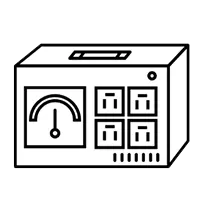Introdução
Um subestação eléctrica é um nó crítico nas redes de distribuição de energia, garantindo que a eletricidade gerada nas centrais eléctricas chega aos consumidores de forma segura e eficiente. Com o aumento da procura de energia fiável, torna-se vital compreender o papel das subestações. Este artigo explora a sua conceção, funcionalidade e aplicações, ao mesmo tempo que aborda questões comuns.
Visão geral das subestações eléctricas
As subestações eléctricas transformam os níveis de tensão e distribuem a eletricidade pelas redes. As principais funções incluem:
- Transformação de tensão: As subestações elevadoras aumentam a tensão para a transmissão a longa distância, reduzindo as perdas de energia. As subestações abaixadoras reduzem a tensão para uso residencial/industrial.
- Distribuição de energia: Dirigir a eletricidade para vários circuitos ou regiões.
- Estabilidade da rede: Monitorizar e regular a tensão, a frequência e o equilíbrio da carga.
- Segurança: Isolar as avarias (por exemplo, curto-circuitos) através de disjuntores.
As subestações ligam os sistemas de produção, transmissão e distribuição, formando a espinha dorsal da infraestrutura eléctrica moderna.
Caraterísticas e especificações
As subestações modernas incorporam tecnologias e componentes avançados:
Componentes principais
- Transformadores: Ajustar os níveis de tensão (por exemplo, 11kV a 400kV).
- Disjuntores: Interrompe automaticamente as correntes defeituosas.
- Barramentos: Condutores que agregam/distribuem energia.
- Relés de proteção: Detetar anomalias e desencadear paragens.
- Protetores contra surtos: Proteção contra raios ou sobretensões de comutação.
Especificações principais
- Níveis de tensão: Subestações de transmissão (69kV-765kV), subestações de distribuição (4kV-33kV).
- Tipos:
- Isolamento a ar (AIS): Económica, com uso intensivo de terra.
- Isolamento a gás (GIS): Compacto, ideal para zonas urbanas.
- Automatização: Os sistemas SCADA permitem a monitorização e o controlo à distância.
Instalação e cenários de utilização
Considerações sobre a instalação
- Localização: Perto de locais de produção de energia, centros de carga ou interconexões de rede.
- Requisitos de espaço: As subestações AIS necessitam de grandes áreas; o SIG adapta-se a zonas com limitações de espaço.
- Conformidade regulamentar: Cumprir as normas de segurança (por exemplo, NFPA 70) e ambientais.
Aplicações comuns
- Integração das energias renováveis: Ligar os parques solares/eólicos às redes.
- Utilização industrial: Fornecer energia estável a fábricas ou centros de dados.
- Distribuição urbana: Tensão descendente para zonas residenciais/comerciais.
- Eletrificação ferroviária: Alimentar comboios eléctricos através de subestações de tração.
Comparação com alternativas
Embora as subestações dominem a distribuição de energia, existem alternativas:
| Caraterística | Subestações | Micro-redes | Distribuição direta |
|---|---|---|---|
| Escalabilidade | Elevado | Limitado às zonas locais | Baixa (apenas distâncias curtas) |
| Fiabilidade | Dependente da grelha | Elevada (capacidade de ligação em ilha) | Moderado |
| Custo | Investimento inicial elevado, manutenção reduzida | Elevado para a pequena escala | Baixo (sem transformação) |
| Caso de utilização | Redes de grande escala | Comunidades remotas | Redes pequenas e localizadas |
As subestações continuam a ser incomparáveis para a transmissão de energia a granel, mas coexistem com as microrredes em sistemas híbridos.
FAQ
1. É perigoso viver perto de subestações?
As subestações emitem campos electromagnéticos (CEM) baixos, que os organismos reguladores consideram seguros. No entanto, as zonas de manutenção exigem um acesso restrito devido aos riscos de alta tensão.
2. Qual é a diferença entre uma subestação e um transformador?
Um transformador é um componente único dentro de uma subestação. As subestações incluem transformadores, disjuntores e outros equipamentos para uma gestão mais alargada da rede.
3. Qual o impacto das subestações no ambiente?
As potenciais preocupações incluem a utilização do solo, o ruído e o impacto visual. Os projectos modernos dão prioridade a disposições compactas e a tecnologias de redução do ruído.
4. As subestações podem integrar as energias renováveis?
Sim. Adaptam-se a fluxos bidireccionais de fontes solares/eólicas, permitindo uma integração eficiente das energias renováveis nas redes.
5. Qual é o tempo de vida útil de uma subestação?
Com uma manutenção adequada, as subestações funcionam durante 30-50 anos. As actualizações (por exemplo, relés digitais) podem aumentar a funcionalidade.
Conclusão
As subestações eléctricas são indispensáveis para o fornecimento eficiente de energia, adaptando-se à evolução das necessidades energéticas. Ao equilibrarem a inovação com a fiabilidade, asseguram que a eletricidade permanece acessível e segura para todos os utilizadores. Quer apoiem redes inteligentes ou energias renováveis, as subestações continuarão a dar energia ao mundo.






